Sunday 30 September 2007
Van Zyl's Golden Mole
Due to its habitat loss, the
Van Zyl's Golden Mole (Cryptochloris zyli) at present is now among the 'critically endangered'. A typical Van Zyl's Golden Mole has a shiny skin of dense fur and an appearance that is- well, to use the word is amusing - formless. One would not see any ear or eye, and truth is, they could not see us either, for they are blind. Its ears are small and buried under all the fur.
Ordinarily, they live in coastal dunes and sandy lands. A Van Zyl's Golden Mole eats invertebrates and lizards (of the legless kind). Offspring of the Van Zyl's Golden Moles see the light of day (light of the earth is more apt) in a grassy cavity on the ground, and speaking of ground, they dig tunnels. During waking hours, they keep on moving. One reason for this: it keeps the temperature on the norm. Did you know this: that sleeping would be catastrophic for them if not for the fact that their muscles move when they are sleeping?
They go through
torpor (inactivity) when the cold season sets in.
Scientists are not quite sure how to classify the golden moles in the animal kingdom.
Interesting fact: On the rare occasion that a person picks up a Van Zyl's Golden Mole with a shovel, it will feign death.
You can help spreading the word about this animal by liking it on facebook
Permanent Link
Thursday 27 September 2007
Falkland Island Fox
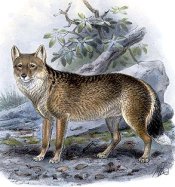
The
Falkland Island Fox is extinct. The scientific name of the Falkland Island Fox (Dusicyon australis) means "foolish dog of the south", referring to the absence of fear towards humans. This does not necessarily mean they are aggressive, it simply meant that were not able to comprehend how dangerous man could be to them. They were the sole predators at the island, and that was why maybe they were put into a false sense of security.
It was also known as "Warrah", the Falkland Island Fox was the sole land mammal of the Falkland Islands...and unfortunately, this animal turned extinct in 1876. Fur of the Falkland Island Fox possessed a brown-orange hue, but its tail was actually white. Food habits of these foxes were unknown. However, experts guess that since there were no native rodents at that place, the diet of the Falkland Island Foxes consists mostly of birds like penguins and grubs, and insects.
First sightings were in 1692 by Captain Strong. Around 1833 or thereabouts, settlers thought of this fox as a danger to the sheep, and out of fear, they set up massive shooting and poisoning. This extermination movement succeeded, and common sense dictates that this campaign was one major reason for the Falkland Island Foxes going extinct.
According to a few historical records, a Falkland Island Fox could get into a tent, and get a piece of meat from under the head of somebody sleeping. One manner described in these documents in the way of killing the foxes: hold out a piece of meat, and with the other hand, have a knife ready for the killing. In 1868, a live one was captured and taken to the London Zoo, but it did not live for a long time.
For more reading
Recently extinct animals
You can help spreading the word about this animal by liking it on facebook
Permanent Link
Monday 24 September 2007
Serval
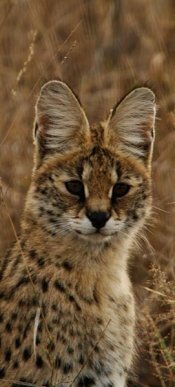
First time I saw the
Serval (
Leptailurus serval) in a picture, I was amused...here was a cat that resembles all three (in varying degrees)- a leopard, a cougar and a domesticated cat. I am talking of the Serval, and they inhabit the jungles and the plains of Morocco, Algeria and South Africa. This felid has a tiny head, round ears, short tail and another animal it resembles is a lynx. The coloration of the Servals is yellow-buff, having light muzzles and underparts. Their coats have dark spots, the ears hold a big spot at the middle. The Serval living in the grass areas has a greater range than those inhabiting the forests, and all-black individuals exist, but they are principally found in Mount Kenya and Kilimanjaro.
The Serval opts to go for food during dawn hours or dusk for that matter, and their number one tool in search of food is their strong hearing. Their diet consists of young antelopes, birds, lizards and rodents too. Sometimes they eat grass just like domestic cats.
Unlike other animals, they do not have a set breeding period, but most of the young are produced during spring. Size of the litter is 2 to 3, and these young's weight increase (by a hundred percent) by just 11 weeks. The Serval (female) traditionally holds a territory whose measurements are 2 to 9 square kilometers, while the males are two times that size. A typical male shows aggressiveness when called for. Little groups of male adults were noted, they usually rest in daytime, and active at night.
You can help spreading the word about this animal by liking it on facebook
Permanent Link
Sunday 23 September 2007
Bryde's whale

The
Bryde's whale (
Balaenoptera edeni) is the least known and the more unusual of the family Balaenoptiidae (Rorquals, whales with throat grooves). They are deep divers, and are seldom seen in groups. Their diet consists of pilchard, mackerel, herring, anchovies, shrimp,crabs, and lobsters and sometimes octopus, squid, and cuttlefish. They are the second smallest of the rorquals (12 meters on average), the Minke Whale being the smallest (about 8.5 meters). Brydes whales have two blow holes on top of their head. As of 1986, they are a protected species worldwide and currently not endangered.
You can help spreading the word about this animal by liking it on facebook
Permanent Link
Wednesday 19 September 2007
Steller sea lion
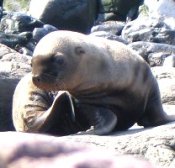 Steller sea lions
Steller sea lions (Eumetopias jubatus) also go by the name of Northern sea lion, it is the biggest breed of sea lions and among
pinnipeds, its bulk size is just second only to the Elephant seal and walrus. The Steller sea lion has magnetized attention these past years due to alarming decrease in so many of their numbers in Alaska's territories.
The adult is lighter in hue than its cousins, range of colors is from yellow to an occasional red. The females are a bit darker than the opposite gender. The male Steller sea lion is just a bit longer than the distaff side and weighs more, from 600 to 1,100 kilograms. The males are also set apart by more pronounced foreheads, flat snouts and curlier hair at the neck.
Range of these sea lions: they are situated from the Kuril to Russia's Sea of Okhotsk to the Alaskan gulf and up to the A�o Nuevo Island. The Steller sea lion from the Kamchatka parts is called to be (under the) Western stock of its kind.
The diet of the Steller sea lion consists of a wide range of fish, mackerel, walleye pollock, salmon kinds, capelin, herring, rockfish, octopus and squids. It is also known that they could eat sturgeon, and very rarely, they feed on otter pups and the Northern fur seals. They have only one natural predator, the orca.
The pregnant female would give birth in their rookery (the birthplace/nest), and after a week staying at the rookery, the female would hunt for food, leaving her newborns alone. After some time, both mother and the young would leave their birth ground. However, since age is very variable for these sea lions, the newborns could stay with the parent for years (4 years had been recorded).
Interesting fact: Cases of a parent feeding her offspring who are at the same time feeding its own newborns have been noted, and this is a very rare action from the mammals' world.
You can help spreading the word about this animal by liking it on facebook
Permanent Link
Monday 17 September 2007
Eastern hog-nosed skunk
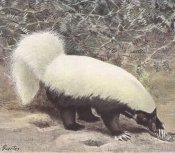 Eastern Hog-nosed Skunks
Eastern Hog-nosed Skunks (
Conepatus leuconotus) inhabit eastern parts of Mexico and Southern Texas. This animal can live in a wide variety of habitats, such as grasslands, forests, scrub lands, coastal plains and even agricultural grounds.
Among the skunks of North America, the Eastern Hog-nosed Skunk is the biggest. It has a long face, short ears and a broad yet bare nose. An individual typically has strong, curved claws, which are used for digging. Akin to all its relatives, the Eastern Hog-nosed Skunk has a scent gland that produces a strong, undesirable fluid which smelss really bad and chases its predators away. Male Eastern Hog-nosed Skunks are bigger than the distaff side, about 18%.
Ordinarily, these skunks are akin to their striped relatives, but the Eastern Hog-nosed Skunk do not have the white line which the
Striped skunks possess. The pelage of these skunks are mainly black, with a solitary, broad white line that traverses the whole back, from the head all the way to the tail's area.
This skunk is very rare, and as such, the behavioral patterns are not well-known. Chances are, they are solitary and nocturnal. At present, the Eastern Hog-nosed Skunk is classified under category 2, and this basically is "Needs Careful Monitoring", but it would not be surprising at all if very, very soon, they would become endangered.
Interesting fact: This breed of skunk and the Common hog-nosed skunk do not live together, but there are expert mammalogists who assert that in all likelihood, they could very well intergrade. Intergrade means to join the two kinds slowly via the breeding process.
You can help spreading the word about this animal by liking it on facebook
Permanent Link
Friday 14 September 2007
Aquatic Genet

(
Osbornictis piscivora) The genets resemble the mongoose, and the Genet Genus (genetta) has 3 subgeneras and 9 species- they can be found in Africa, end part of the Sahara territories. They can also be seen on the Arabian peninsula, and some parts of the European continent. They have a long body, short feet and a pronounced snout, ears and claws which are both retractile and curved.
The genets in general reside in forests and savannas, and they eat mainly birds, rodents and insects. An
Aquatic Genet specifically could be found in the Democratic Republic of the Congo (north-east parts). A male Aquatic Genet weighs about 1.43 kilograms while females are in fact heavier, going by 1.5 kilograms- but that is just the norm.
Aquatic Genets are red to pale red, the tail is basically black, and they have white spots in the middle of the eyes, the side/front of muzzle are white-shaded. Fur of an Aquatic Genet is dense and long, most particularly at the tail's area. Soles and palms are not furred. Its skull is long, the teeth are tiny and not strong. Experts maintain that their bare palms are utilized feel for the fish in holes (dirty and murky). The fish are the main food of the Aquatic Genet, but of course, they subsist on other kinds too.
It feeds on fish, but it actually isn't a good swimmer.. They would strike its paw on the water's surface, to entice the fish to come near. Then, it would put its whiskers on the surface to identify the movements of its prey. Once it senses that there is fish underneath, it catches it. Some experts believe that they wait for the fish to appear on the surface before catching it, but there are some experts who contend that they would dive in. Which of the 2 groups you'll believe in, it's your call...as for me...I would like to believe that it is logical to assume that they could do both.
Interesting fact: It has been debated by circles of experts for the longest time, on whether this genet avoids being wet as much as possible
You can help spreading the word about this animal by liking it on facebook
Permanent Link
Wednesday 12 September 2007
Six banded armadillo
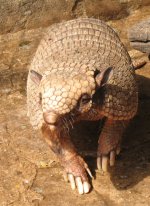
The
six banded armadillo (
Euphractus sexcinctus) lives in Suriname, east of the Andes from the Amazon basin in Brazil to central Argentina and Uruguay. It is the most common type of armadillo in Argentina. Unlike other armadillos, they are active during the day, and come out at night only occasionally. Their diet consists mainly of plants, which is supplemented by insects, carrion. The six-banded armadillo, has, as its name implies, six bands. This is not always the case: the
nine-banded armadillo can have between 7 and 11 bands. Six banded armadillos are often trapped by farmers, because the armadillos love to feed on the corn shoots.
Links
Armadillo Online
You can help spreading the word about this animal by liking it on facebook
Permanent Link
Sunday 09 September 2007
African Linsang
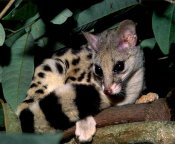
The
African linsang (
Poiana richardsonii), or 'oyan', could be found in Western Africa from Sierra Leone to northern Congo, and
Bioko, a small island off the coast. They have been known to live at heights of 950m in Zaire and at 300-500m in North-east
Gabon. The normal head/body length is 33 to 38 centimeters for both sexes, and the tail adds another 35-40 centimeters. They weigh only 500-700 grams.
African linsangs' ventral side are white or cream in color, dorsal sides hold circular marks which are dark. Sometimes, an individual could have a black thin stripe going from the nose to the tail's root. This tail holds 10 to 14 rings which differ in measurement. An African linsang has soles that are full of hair.
The breeding occurs once or twice annually, but when they do this exactly is just guesswork even for the experts/biologists. The number of newborns though are known, they are 2 to 3. When born they are altricial (naked and blind). They can become 5.3 years on average in the wild.
The African linsang is nocturnal, and lives either alone or with another member. They construct arboreal nests (2 meters above the ground) of green material where they sleep in just for a bit of time, then they move on and make another home. Very rarely, many linsangs would stay at the same resting place.
They are by nature omnivorous, and their diet consists of birds, insects, cola nuts and fruits. They could also take small vertebrates, but it is safe to assume they eat them only if the opportunity rises, they would not really hunt for it.
Interesting fact Humans are the only known predators of the African Linsang. Non-human predators may include larger carnivores, owls and snakes, but has not been observed.
Picture of the African Linsang by Alessio Marrucci, licensed under
GFDL
You can help spreading the word about this animal by liking it on facebook
Permanent Link

 The
The  First time I saw the
First time I saw the  The
The 

 (Osbornictis piscivora) The genets resemble the mongoose, and the Genet Genus (genetta) has 3 subgeneras and 9 species- they can be found in Africa, end part of the Sahara territories. They can also be seen on the Arabian peninsula, and some parts of the European continent. They have a long body, short feet and a pronounced snout, ears and claws which are both retractile and curved.
(Osbornictis piscivora) The genets resemble the mongoose, and the Genet Genus (genetta) has 3 subgeneras and 9 species- they can be found in Africa, end part of the Sahara territories. They can also be seen on the Arabian peninsula, and some parts of the European continent. They have a long body, short feet and a pronounced snout, ears and claws which are both retractile and curved.  The
The  The
The